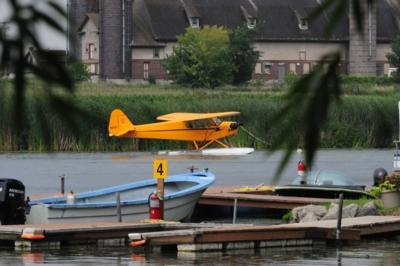Previous Edo Exec Still Flies And Maintains Close Ties With The Company
By Maria Morrison
JJ Frey, author of the iconic “How to Fly Floats”, was originally convinced to write the book, which is now regarded as “the basic training manual for the world of seaplane flying”, by his boss at Edo. The pre-Kenmore company was based out of Long Island, New York, when Frey joined them in the early 1960s. He was working as the Vice President of the Seaplane Operations when he published the book, the first promotional publication for the company, which has now sold over 225,000 copies.

Edo began in the 1920s as an airplane manufacturing business, and quickly specialized in the production of straight floats. The floats were known for staying leak-free much longer than the traditional wood floats of the day because they were manufactured out of aluminum. Edo was the first to develop the aluminum floats and a process of piecing the metal together without leaks, which meant installing roughly 5000 rivets per float. The Edo company ultimately produced over 300 different models of floats for aircraft that ranged from Piper Cubs to Tri-Motors. Unfortunately, Frey stated, “It’s hard to make money with metal aluminum floats,” and Edo was sold to Kenmore Aero Services in 1983.
After 5000 hours of seaplane time and 45 consecutive years at Oshkosh, JJ Frey has experienced a great deal of both issues and successes in floatplanes. Those many experiences include hundreds of grass landings on floats, most of which required a dolly to depart. Within his book, Frey also details flying into the grand canyon, and some of his very few occasions of flying into the ocean, which he strongly advised against. “Straight floats can’t handle big water. The J3, for example, is great but can’t handle [swells] more than the height of the float.” Frey urged others to fly seaplanes, calling it a “very easy and rewarding rating.”
Other advice for new seaplane pilots included normal operating procedures for bases. Most are fairly clean and there is no worry in regards to hitting something. However, he heavily stressed the importance of overflying the base first to check for logs or other debris. “If you do hit something, these floats are made with 025 or 030 aluminum and you can easily tear a hole. But good ones have five compartments, so if you flood one then you won't lose the airplane.” Overflying is also helpful to find indicators for wind direction, which can be hard to determine in fairly calm water.
A final piece of advice to younger pilots is to be wary of saltwater operations. “If you’re going to operate in saltwater, you need a very good procedure for maintaining [the airplane].” Freshwater is ideal to Frey in order to stop corrosion and wear to the floatplane. He gave the example of Kenmore, with whom Frey still works closely. “They take off and land out of saltwater every day, but they have a very set procedure for cleaning up afterwards.”
(Staff image)
 ANN's Daily Aero-Linx (05.04.24)
ANN's Daily Aero-Linx (05.04.24) NTSB Final Report: Quest Aircraft Co Inc Kodiak 100
NTSB Final Report: Quest Aircraft Co Inc Kodiak 100 Aero-News: Quote of the Day (05.04.24)
Aero-News: Quote of the Day (05.04.24) Aero-News: Quote of the Day (05.05.24)
Aero-News: Quote of the Day (05.05.24) Read/Watch/Listen... ANN Does It All
Read/Watch/Listen... ANN Does It All



